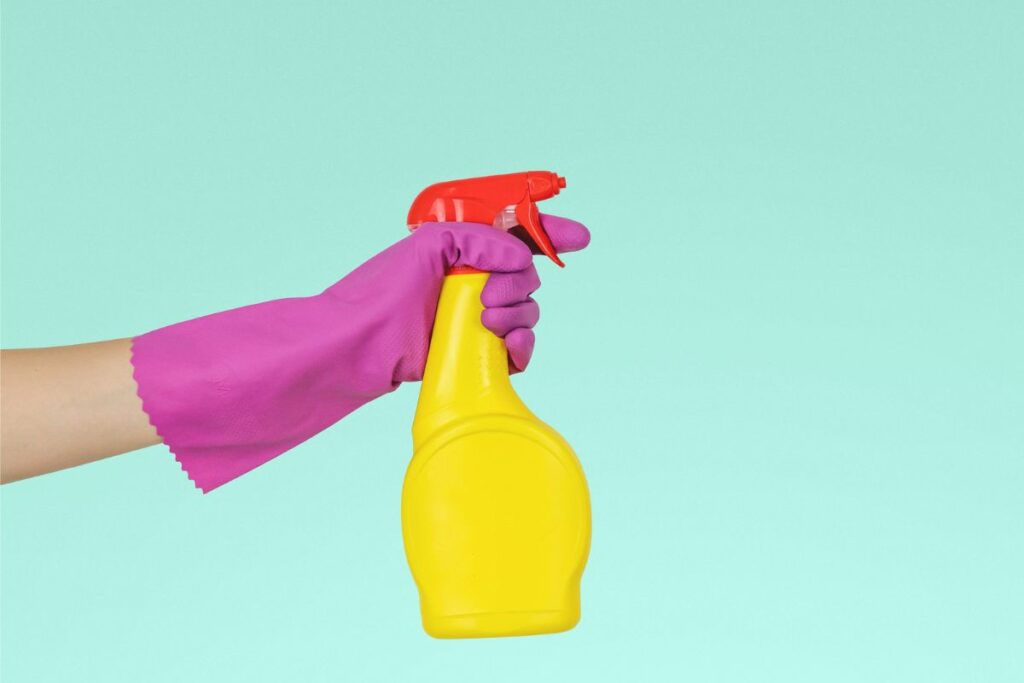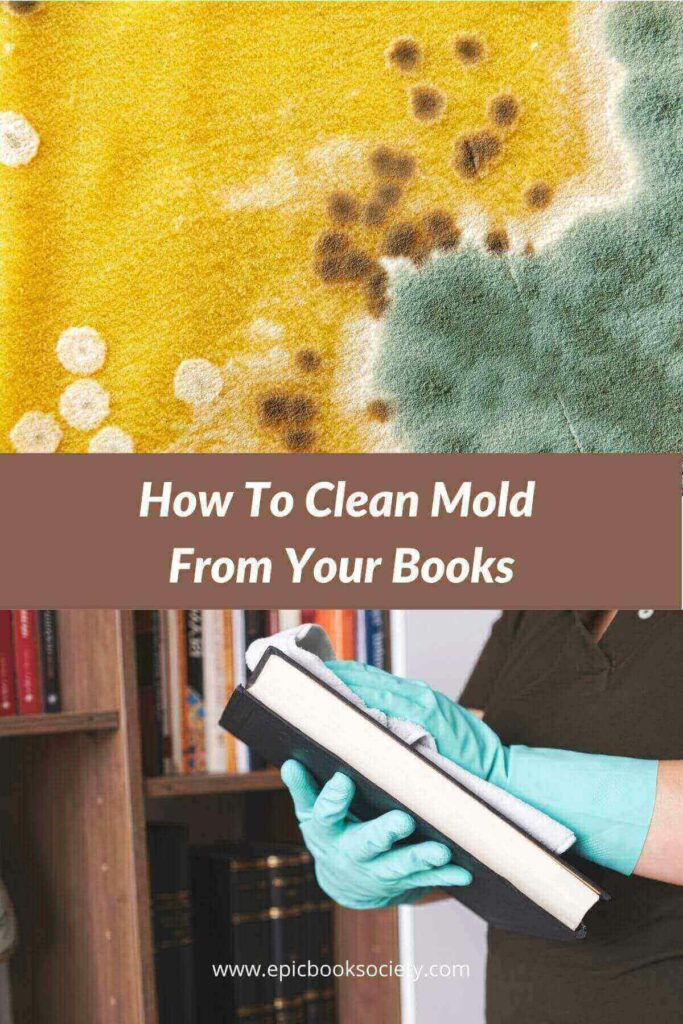Last Updated on August 18, 2023 by Louisa
There’s nothing worse than noticing that my beloved books have been invaded by mold and mildew.
When I first discovered mold in one of my books, I thought it was the end of the world. I was sure that I was going to have to throw them away.
But fear not, as it turns out, there is a very easy way to remove mold and mildew from books and restore them to their original glory.
It’s also important to know how to prevent mold from growing in books, as it was my poor storage choices that led to the mold growing in the first place.
If you’re looking to restore your books after being damaged by mold and want to learn ways to prevent mold growth, see my top tips below.
How to Tell If There Is Mold in Books
Not only does mold look unpleasant, but it can also lead to health issues such as respiratory problems, so it’s important to ensure you check your books for any signs of mold or mildew.
You can usually detect mold by seeing a growth in your book. Usually, the growth is black or bluish-green, but it can be in any color.
Sometimes you may find white stains appearing on pages that look like paint splatter – this is a sign that mildew is growing.
Usually, the warning signs of mold are based on environmental factors. If you have had water damage before, or if the room feels humid and muggy, then might find mold growing.
How to Prevent Mold in Books
But before I dive into the moldy book cleaning process, it’s important to note that prevention is key…
Make sure your books are stored in a dry and well-ventilated area, away from dampness, and sunlight.
You might think that sunlight is good for keeping books dry, but it also makes the pages of your books turn yellow, so try to avoid putting books in the sun.
Also, avoid stacking books too tightly as it can trap moisture and create the perfect environment for mold and mildew to thrive.
You should also check your books on a regular basis for signs of mold and mildew especially if you live in a humid environment. You should also check for insect damage, as insects like to hide in books when the weather gets hot and humid.
Toby Schulz, CEO of Maid2Match, agrees. He says, “if you notice insect damage, seal the book(s) in a plastic bag and keep them in the freezer for 24 hours to kill the insects.”
A top tip for restoring a damaged book that has water damage but not mildew is to sprinkle it with cornstarch to soak up any moisture. Then leave it somewhere well-ventilated to dry.

How to Clean Mold in Books

If you have discovered mold in your books, then the first thing is to not panic. There is a way to salvage your books and rid them of this pesky mold.
Before you start tackling the cleaning of your books, be sure to gather your materials first.
You will need the following items:
– Face mask and goggles: when cleaning, wear a face mask and eye protection so you can avoid getting any mold into your sinuses.
– Rubber gloves. Wear these to protect you from getting any mold on your skin.
– A hoover with a brush.
– Rubbing alcohol or hydrogen peroxide
– Warm water.
– A spray container.
– A towel.
– A soft bristle brush for cleaning. An old toothbrush works best.
– A dry, makeup brush of soft bristle brush.
– Bicarbonate of soda (baking soda)
– A dry microfiber cloth or kitchen towel
Before you start cleaning, I recommend you place a towel on a flat surface so you can use it to dab any excess water where required.
Now on to the cleaning…
Step 1: Isolate
The first thing you need to do is to separate the books that need cleaning from the ones that are unaffected.
Make sure you wear protective equipment so you don’t touch or inhale mildew spores.
Step 2: Kill the mold
Gather up the affected books and put them in a dry place for a few days.
This will ensure that the mold is deactive.
According to the Alabama Department of Archives, a room needs to be in less than 55% humidity to kill the mold.
Only when the mold is dead (dry and powdery and doesn’t smear when touched) can it be cleaned and we move on to the next step.
Step 3: Prepare the book
The first thing you want to do is make sure the book is completely dry.
If you are finding that your book pages feel a little damp, use the cornstarch method mentioned earlier to remove any moisture.
Then you can give them a quick hoover to remove any loose mold or mildew spores.
Do not use a brush, as this will allow mold spores to fall into the air. A hoover collects the mold and stores the spores in a container that it can’t escape from.
Just remember to throw out the hoover bag (in an outside bin) after you have finished the cleaning process.
Step 4: Prepare the cleaning mixture
Fill a small spray container with half rubbing alcohol or hydrogen peroxide and half water. Make sure that the alcohol has been diluted to at least 50:50.
It’s important that you dilute the alcohol first, as using harsh chemicals can damage your books and weaken the structure of the pages.
Step 5: Start cleaning
Spray a bit of the mixture onto a dry microfibre cloth or paper towel, and gently start to scrub at the mold.
Start with the cover and the spine and be sure you pay attention to the corners and gaps between the pages and the cover.
When it comes to cleaning the pages use a dry cloth to wipe the mildew spores off the pages.
I recommend you work from left to right and work across the page, so you don’t rub any mold back into the area you have just cleaned.
Remember to keep the cloth clean and rinse it regularly so you don’t rub any mold back into the page.
If you have any stubborn mold spores, you may find using a soft bristle brush, such as an old soft bristle toothbrush, is more effective. Be sure that the toothbrush is clean first.
Step 6: Dry the pages
Once you’ve scrubbed the entire book, use a clean, dry cloth to wipe away any remaining residue of the mixture.
Make sure the book is as dry as possible, and then place your book in a well-ventilated area to dry completely. Make sure it’s not exposed to direct sunlight or heat as this can damage the pages.
Michael Bogoyavlenskiy, Director of Cleaning Express, agrees. He also says that a good way to prevent mold growth is to keep your books in sealed plastic bags with silica packets.”
I agree that the silica packets will help soak up moisture and prevent mold growth, but be careful when storing books in plastic bags as they can also retain moisture.
If you store books in plastic wraps, ensure that they are airtight so mold cannot grow (it needs oxygen to grow). You can use a vacuum seal bag for this.
You can also add a dryer sheet inside the bag to help eliminate odors.
Another top tip is if your book is old and has that musty smell, you can place some baking soda on the pages and put it in a seal-tight container for 30 minutes. This will help get rid of the odor.
It’s important to note that some books may be too damaged by mold and mildew to be salvaged.
If you notice the pages have started to crumble or the mold has penetrated too deeply, it may be time to say goodbye to your book.
Here is a quick video that shows you the process of how to clean mold from your books.
FAQs About Cleaning Mold From Books
Here’s what people usually ask about cleaning mold from books…
How do you get mold off a bookshelf?
Getting mold off the bookshelf is much easier than the book. Scrub the bookshelf with warm soapy water and a soft bristle brush, and then wipe the liquid away with a dry microfiber towel.
Does mold from books spread?
Yes, mold is transferred from one book to another through the air. Once one book has it, it’s likely others will too.
Can mold permanently damage books?
Yes, it can weaken the paper as well as cause the paper to crumble, the cover to decay, and also cause the text or images to discolor beyond recognition.
Final Thoughts
Removing mold and mildew from books may take time and effort, but it’s well worth it to preserve your favorite reads.
Just remember to store your books in a dry and well-ventilated area to prevent future mold and mildew growth.
Like this post? Don’t forget to save it on Pinterest.


